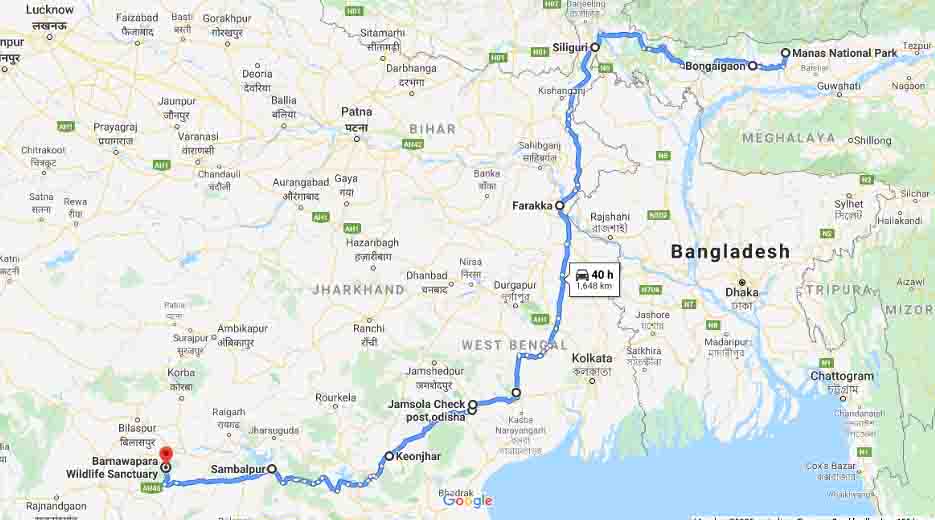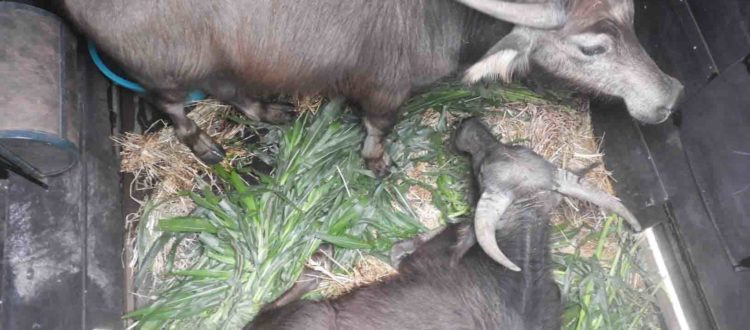WTI assists in Wild Buffalo translocation to Chhattisgarh
Barnawapara, 23 April 2020: In a meticulously planned and historic operation, the Chhattisgarh forest department has with the active support of the Wildlife Trust of India translocated two wild buffaloes – one male and one female, from Manas National Park in Assam to the Conservation Breeding Centre in Barnawapara, about 130 km east of Raipur, the state capital of Chhattisgarh. A page in conservation history of this bovine was written with this pair of buffaloes completing a road trip of over 1900km in specially designed vehicles in four days to arrive in Chhattisgarh where they will be the founders for conservation breeding planned to augment the dwindling population of its State Animal.
WTI has been working for more than a decade to recover the population of the Wild Buffalo (Bubalus arnee) in Chhattisgarh from a time when only about 50 individuals existed in the state in 2006-07 and there was only one female and six male individuals in Udanti Wildlife Sanctuary. The State Animal of Chhattisgarh thus had to be brought back from the brink, with the foremost challenge of stabilizing the small population. A long process that involved taking care of the remaining wild buffaloes in Udanti to avoid any unnatural mortality, sensitisation of policy makers and public, ecological interventions for habitat improvement and campaign. Population augmentation through conservation breeding was one of the most crucial planned actions, which will have effected through the individuals from Manas, Assam, that holds a genetically similar and good population of this flagship species.
With the current population of eight males and one female buffaloes, it was imperative that serious assisted augmentation processes are utilized through planned breeding and release program to recuperate naturally in the landscape. For this, females in prime were needed to build the release stock in captivity. The collaborative project of Chhattisgarh Forest Department and WTI, supported by Oracle, the wild buffalo conservation project is reaching a milestone with first lot of buffaloes translocated from Assam contributing to establish a viable population in Chhattisgarh.
The pair of buffaloes from Manas National Park were thus translocated to Chhattisgarh amidst nationwide lockdown. This was made possible through concerted efforts and coordination of the Chhattisgarh State Forest Department during lockdown for movement permits from the various states along the planned route of this convoy carrying the precious cargo. Permissions from the Chhattisgarh State Wildlife Advisory board, the Ministry of Environment, Forest and Climate Change, the National Tiger Conservation Authority and Assam state government had been already obtained for this movement.
[acx_slideshow name=”wildbuffalo”]
A thirteen-member team of the Chhattisgarh forest department including veterinarians, forest guards, drivers and keepers had camped at Manas National Park from the 10th of February 2020 with three rescue vehicles, specially customized for the translocation. At Manas, Wildlife Trust of India team comprising of three veterinarians, two biologists and three keepers also joined the Chhattisgarh team for the identification, capture and holding of animals in Manas NP. A special team of biologists and veterinarians from Assam FD and Wildlife Trust of India had been engaged in the designing of an enclosure facility in Manas and consequent identification and holding of two buffaloes, which were to be transported in the first phase of the translocation.
The team had successfully captured two wild buffaloes (one male & one female) and transferred them to the boma (temporary holding facility). Tissue and blood samples of the captured wild buffalos were sent to CCMB, Hyderabad for genetic studies on compatibility. A positive compatibility report from CCMB, Hyderabad was essential for a successful conservation breeding program of the wild buffaloes in Chhattisgarh. Meanwhile four other members from Chhattisgarh also reached Manas to assist in this translocation.
While a positive compatibility report had been received, the ongoing Covid-19 crisis had led to postponing of plans. The team from Chhattisgarh had been put up in Manas for more than a month now, awaiting the end of the country-wide lockdown. Eventually, it was decided to go ahead and armed with permissions from Assam, West Bengal and Odisha state government, they started their journey of about 1900 kilometres from Manas on the 15th of April, 2020. The convoy safely reached Barnawapara WLS on the 18th of April 2020.

Route map from Manas NP to Baranwapara
The pair of wild buffaloes were released in the Conservation Breeding Centre at Baranwapara. Atul Kumar Shukla, PCCF (WL), A.K. Pandey, APCCF (WL), Anurag Srivastav, CCF (Wildlife) and R. P. Mishra of Wildlife Trust of India welcomed the team and congratulated them for their commendable efforts in the first such translocation of wild buffaloes in India.
The wild buffaloes, each about 2.5 years old, have been successfully released into the artificially created holding facility where they will now be under precautionary quarantine for the next 14 days.
Post quarantine, the buffaloes will be released into the 10 ha enclosure that has been specifically designed to recreate their home environment. Solar pumps and sprinklers, a 100 sq mtr water body with a depth of 10 feet are some of the features provided in the enclosure to recreate a habitat similar to the one in Assam. The rest of the enclosure is dotted with grasslands and tropical dry and deciduous forests and is bounded by a solar fence restricting the entry of predators inside the facility.
“It is an immense pleasure to note that the two wild buffaloes have been successfully translocated to Chhattisgarh from Manas National Park in Assam. The animals are healthy and doing well. We hope that we will soon be able to bring four female wild buffaloes in the next phase of the translocation to augment the current population of our state animal” concluded Arun Kumar Pandey APCCF (WL), Chhattisgarh









